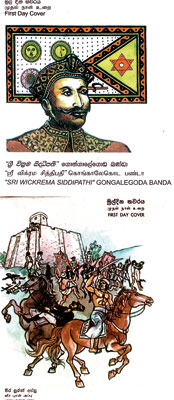Yesterday we celebrated the 64th anniversary of Independence. It was on February 4, 1948 that Sri Lanka gained Independence from the British. So it's time to reflect upon the 'Freedom Fighters' who worked hard to free the country from the clutches of the colonial masters.
Foreign domination started with the arrival of the Portuguese in
1505 AD and occupying the maritime provinces of Sri Lanka, then known as Ceylon. They were replaced by the Dutch in 1656, when they captured Colombo and other strongholds held by the Portuguese.
The British drove away the Dutch in 1796 and occupied the maritime areas. They gained complete control of the country in 1815 when the Kandyan kingdom was ceded to the British by Kandyan chiefs who had turned against the king. Thereafter Sri Lanka remained part of the British Empire.
It didn't take long for the people to realise the need to fight against imperialism. The Uva uprising (1817 – 18) saw the people of Uva and Vellassa rebel against the new
rulers. It was a people's rebellion with several chieftains joining it,
the most prominent being Keppetipola Disawa.
The British had to bring troops from India to subdue some of the provinces. Keppetipola was captured at the end of October 1818 and along with Madugalle Dissawa was court-martialled and beheaded the next month.
With the
imposition of a series of
unjustifiable taxes like the cart and boat tax, stamp tax, gun tax, personal tax, road tax and the dog tax, the
people revolted in 1848.
Following this, a young man from the coastal town of Moratuwa went to Kandy and led the proud peasants of the hill country in an armed
insurrection against British rule. He captured the town of Matale and declared
himself king. The brave 35-year old young man was Veerahennedige Francisco Fernando – better known as Puran Appu.
He was caught by the British army and executed on August 8, 1848.
Gongalegoda Banda alias Peliyagoda David (his name was Wansapurna Deva David) declared himself king when the 1848
rebellion spread to Dambulla.
At the Dambulla temple amidst thousands of people, he was crowned 'King of the Kandyan Kingdom' by the chief incumbent of the Dambulla temple, Ven Giranegama Ratanajothi Thera giving him the name 'Sri Wickrema Siddipathi'. He was captured by the British and banished to Malacca where he had died in December 1849.
Stamps have been issued to
commemorate these national heroes.
Having realised the futility of attempts to fight a strong foreign army, the national leaders later began to campaign on different platforms. There were leaders who concentrated on campaigning for national resurgence, the promotion of traditional values and securing a place for Buddhism.
Among the prominent
personalities was Venerable Mohottiwatte Gunananda Thera (Migettuwatte Gunananda Thera) (1823 – 90) – born orator, fearless debater, erudite scholar and
inspiring writer. He led the
movement for the revival of
Buddhist education in the
country and the ushering of a
spiritual and national renaissance.
Operating from Deepaduttaramaya at Kotahena, he published books and distributed tens of
thousands of leaflets to
propagate the teachings of the Buddha. He accepted the
challenge from Christian
missionaries and took part in five public debates held in different parts of the country and emerging victorious. The historic debates are identified by the places where they were held – Waragoda (1865), Udammita (1866), Gampola (1871), Baddegama (1871) and Panadura (1871).
His writings attracted the
attention of the advanced
West and it was his influence through his writings that brought Colonel Henry Steele Olcott and Madam Blavatsky to Sri Lanka in search of Buddhism. They became part and parcel of the national
revivalist movement and
Colonel Olcott's contribution to Buddhist education through the
establishment of educational
institutions like Ananda College in Colombo, Mahinda College in Galle and Dharmaraja College in Kandy was greatly appreciated.
Then there was the dynamic
leader Anagarika Dharmapala
(1864 – 1903), the campaigner in the cause of Buddhist resurgence who travelled the length and breadth of the country in a bullock cart,
inspiring the people with hard-hitting speeches to work for the development of the country and towards
achieving
independence.
Meanwhile, on the
political front, other leaders
started
campaigning for more
responsibility in governing the country with the aim of reaching the goal of
becoming an independent nation. |



